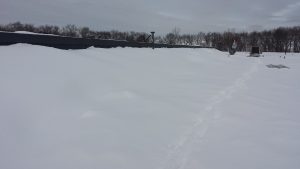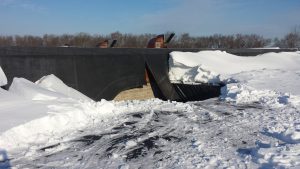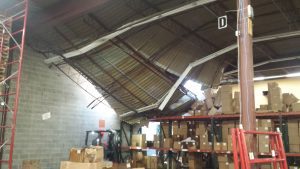Sparkling snow on a country field, perfectly unmarked, is a beautiful thing, and should you cross-country ski in a park like Chatfield Hollow in Connecticut, you will be left in awe of how winter transforms forests into magical places. But what about the snow that sits on your roof, making you uneasy as you squint in the sunlight, staring up at it – should you remove it?
What do the experts say?
Buildings are structurally designed to handle a certain amount of ice and snow.
The Federal Emergency Management Agency (FEMA) has published a Snow Load Safety Guide, which you can read here. As FEMA points out, most buildings are perfectly safe when there is snow on their roofs; they are structurally designed to put up with a certain amount of snow and ice.
The amount of snow that each building is designed to hold varies from state to state, town to town. Massachusetts building code currently requires the following for each town: Read Here. Section 1608.2 states that ground snow loads are used to determine snow loads for roofs. As a result, look for “Pg” in the Table 1604.11. Please keep in mind that these are based on today’s 8th edition building code. The requirements were likely different when your building was built.
You would not be safe up there
Climbing up on a roof to remove ice and snow is, simply put, dangerous: In 2015, over 100 inches of snow fell on parts of Massachusetts in about a month, and two workers in Canton lost their lives while clearing snow from rooftops, falling through skylights – and these unfortunate men were working as professional snow-clearers.
My roof is probably safe?
It would be highly reassuring if someone could tell you that the roof of your business dwelling or your home will never, ever collapse from the weight of the snow that sits on it. But this is simply not possible.
What is possible?
– You can calculate the weight of snow that is sitting on your roof, go here to find a nifty calculator, and if it is an unsafe amount, you can call a professional to remove it for you.
– If you cannot afford to hire a professional, you should still stay on the ground and, at the most, use a roof rake to remove some of the snow: Popular Mechanics published this advice on staying safe while using a roof rake.
– If your front or back door has jammed, or if the rafters if your attic are bending as a result of the weight of snow, you should call in a structural engineer to review the situation and make recommendations.
Before Roof Collapse
After Roof Collapse
After Roof Collapse – Inside the building
Important areas to keep an eye on
– Snow drifts that exist on the roof. These are typically areas where snow has a chance to build up along a wall, rooftop unit, or other obstruction. If snow doesn’t have the opportunity to blow off the roof or spread evenly throughout the roof, a lot of weight may be concentrated in one area.
– Blocked roof drains, scuppers, downspouts and gutters. If water doesn’t have the opportunity to leave the roof system, a lot of weight will remain on the roof. This can be particularly problematic on low slope or flat roof systems.
– Wet, heavy snow on the ground in areas you haven’t shoveled or piled snow. Chances are, if snow you haven’t shoveled on the ground is wet, thick, and heavy, similar conditions exist on your roof. The lower the slope on your roof, the harder it is for snow to slide off.
It is ridiculously easy for us human beings to convince ourselves that we will not be injured while completing a task that we believe will make our buildings safer, so if you are considering lacing up your best winter boots, the ones with the serious grips, and heading up a ladder on a sunny winter day, just stop, and remember:
– All roofs are designed to handle a certain amount of snow. As a result, ridding your roof of snow may not be necessary – but you should always be mindful and cautious.
– If you think it might be necessary, you can reference this calculator.
– If you have any doubts or concerns, call a professional with a reputation for safety, who will clear your roof while you work, or watch football, or make your signature spaghetti sauce.
A roofing contractor is the most qualified professional to handle roof snow removal. They will know how to get the job done safely without damaging the underlying roof system. Read more about professional snow removal here.



